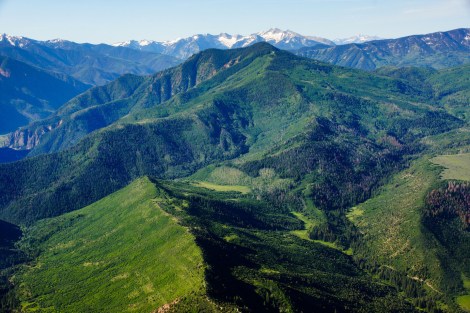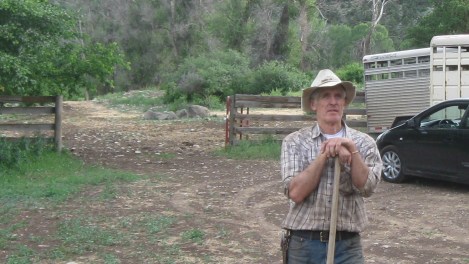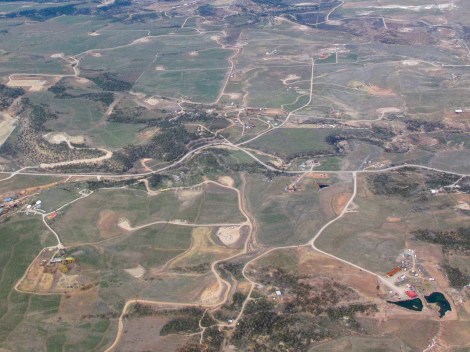If you take off in a plane from the airport in Aspen, Colo., you’ll soon see exactly what natural gas drilling looks like — and exactly why so many residents of the surrounding region, from ranchers to business owners to greens, are fighting to keep it in check.
Fly north over the Thompson Divide, a region mostly contained within the White River National Forest, and all you see is green, lush mountains and valleys. This is a habitat for migratory species from birds to elk.

Bruce Gordon / EcoFlight
Continue on, and tilt a bit west, and you enter the Piceance (pronounced “Pee-once”) Basin. There you see patches of denuded brown dirt with long thin lines leading to them, like the pitcher’s mound on a baseball field. These are some of Colorado’s roughly 30,000 active gas wells, and the roads built to service them. (Many thanks to EcoFlight, a nonprofit environmental education group, for showing me the views.)
Gradually, over the course of recent years, the drilling has spread eastward, over each successive hill. Now residents in the Thompson Divide area are worried it will come down to their communities and soon their pristine landscape will look like their neighbors’ to the west. The threat has been hanging over them for a decade, but they are now trying to round up the votes in Congress to roll it back.
In 2003, the Bush administration unexpectedly issued 81 mineral leases in the area covering approximately 105,000 acres. Many sold for the statutory minimum of $2 per acre. President Bush’s subservience to fossil fuel interests is one possible reason for the low price, but it was also because the natural gas in the area is expensive to extract, so companies weren’t willing to pay much for the right to do so. Gas prices still haven’t risen enough to make drilling here economical, so a decade has elapsed without any drilling actually taking place. The leases were for 10 years, but some got an extension from the Bureau of Land Management last year, so now there are 61 active leases.
The Thompson Divide Coalition, a grassroots organization of local farmers, ranchers, business owners, and environmentalists, is fighting to revoke the remaining leases permanently. The group contends that it makes no economic sense for the government to let gas companies hold on indefinitely to leases they aren’t using. Be that as it may, the coalition’s more compelling argument is that drilling would be devastating to their local environment and economy. The White River National Forest starts right at the top of Aspen Mountain. The area’s main economic activities are tourism, outdoor recreation, and cattle ranching. All would be under threat by gas drilling that could pollute the local air and water and would require building roads and filling them with trucks. Constructing and servicing a well, especially a fracking well, can require dozens of truck trips back and forth per day. No one wants to hunt, hike, fish, or cross-country ski in an area with pungent, loud drilling operations and frequent truck traffic.
For the owners of adjacent ranches, the impact could be just as immediate. They graze their cattle in the White River National Forest, and they might no longer be able to if the area were drilled. Around the country, cattle have died after drinking water contaminated with fracking fluid.
Bill Fales, 61, looks like Mad Men’s Roger Sterling would if he went into ranching. Tall, lean, gray-haired, with piercing blue eyes and a lined face under his cowboy hat, Fales runs a 700-acre ranch in Carbondale, Colo., with his wife Marj, who grew up on the land. They now sell their grass-fed beef to Whole Foods. They were among the first organizers of the Thompson Divide Coalition.

“We’re pretty terrified by [drilling],” says Fales. “We’re worried about the quality of our water. Just the perception of contamination kills our grass-fed market.” In New York City, Fales notes, some restaurants stopped buying beef from farms upstate as soon as the threat of fracking nearby materialized. Fales adds that herding his cattle would be difficult if the area were broken up with roads and filled with traffic.
All of this has brought together a slightly unusual coalition against drilling in the area: hunters and cowboys holding hands with environmental organizations like the Wilderness Workshop, an advocacy group focused on the White River National Forest.
Sen. Michael Bennet (D-Colo.) introduced a bill last year that would protect the Thompson Divide from any future lease sales and set up a process for allowing the community to buy current leases from the gas companies and retire them. Colorado Gov. John Hickenlooper (D) and Sen. Mark Udall (D) have announced their support for the legislation. A similar bill focused on Wyoming land passed and was signed into law in 2009 with Republican support. Still, getting Bennet’s bill through the Senate will be hard: The Energy and Natural Resources Committee is chaired by oil-industry booster Mary Landrieu (D-La.) and includes pro–fossil fuel Democrat Joe Manchin (W.Va.) as well as Republican members. Back-channel negotiations between drilling opponents and gas companies are ongoing, and an agreement that removes industry opposition to Bennet’s bill could round up some support from Republicans and industry-friendly Democrats. But getting anything out of this polarized Congress, and especially the GOP-led House, is never a safe bet.
So the Thompson Divide Coalition and its allies are pursuing another approach as well: They’re petitioning the BLM to revoke all 61 remaining leases. They argue that the BLM did not perform the legally required environmental reviews back in 2003 and citizens were not given proper warning and an opportunity to comment on the leasing plans. The BLM itself admits that the review process was “deficient,” so in April of last year it suspended the leases for two years while it figures out whether that means the leases should be revoked or extended. Getting the BLM to rule that the leases should never have been granted would force the gas companies to come to the table and negotiate a settlement.
The Thompson Divide’s defenders are waging a PR battle too. They’re lobbying in Washington, and organizing in Colorado and online. The Thompson Divide Coalition commissioned a study last year that found hunting, fishing, grazing, and recreation in the Thompson Divide create nearly 300 jobs and $30 million a year in economic value. They argue, also, that those industries are more sustainable than natural resource extraction. “People come because it’s so scenic, and they won’t come if it’s been destroyed,” says Fales. “We’re not a boom-and-bust business. Western Colorado has seen a lot of boom-and-bust mineral development.” Indeed, Carbondale has always served as a bedroom community to Aspen. The area was developed in the late 1800s when Aspen had a boom in silver mining and Carbondale was its agricultural breadbasket. Then Carbondale experienced a coal mining boom, which literally exploded with a methane leak that killed 15 miners in 1981. The town suffered after the industry shut down, until Aspen’s tourism economy and the influx of service workers revived it.
The Thompson Divide’s defenders make arguments about money, because that is what politicians respond to. But the bigger issue is their connection to the land.
Given the striking views of Mount Sopris from their driveway and their proximity to Aspen, the Fales’s could sell their property for millions of dollars to a developer of luxury vacation homes and get out now, before any potential drilling has started. Instead, they have put a conservation easement on their property and stayed to fight it out with the gas companies. When asked about moving, Fales just shakes his head and says, “This is our home.”
—–
Watch EcoFlight‘s virtual tour of the Thompson Divide area:




